Herpes zoster ophthalmicus (HZO), also known as ophthalmic zoster, is shingles involving the eye or the surrounding area. Common signs include a rash of the forehead with swelling of the eyelid. There may also be eye pain and redness, inflammation of the conjunctiva, corneaoruvea, and sensitivity to light. Fever and tingling of the skin and allodynia near the eye may precede the rash. Complications may include visual impairment, increased pressure within the eye, chronic pain,[1][2][3] and stroke.[4]
| Herpes zoster ophthalmicus | |
|---|---|
| Other names | Ophthalmic zoster |
 | |
| Herpes zoster ophthalmicus | |
| Specialty | Ophthalmology |
| Symptoms | Rash of the forehead, swelling of the eyelid, pain and red eye |
| Complications | visual impairment, increased pressure within the eye, chronic pain, stroke |
| Causes | Reactivation of varicella zoster virus |
| Risk factors | Poor immune function, psychological stress, older age |
| Diagnostic method | Based on symptoms |
| Prevention | Herpes zoster vaccine |
| Medication | Antiviral pills such as acyclovir, steroid eye drops |
| Frequency | Up to 125,000 per year (US)[1] |
The underlying mechanism involves a reactivation of the latent varicella zoster virus (VZV) within the trigeminal ganglion supplying the ophthalmic nerve (the first division of the trigeminal nerve). Diagnosis is generally based on signs and symptoms.[2] Alternatively, fluid collected from the rash may be analyzed for VZV DNA using real-time PCR. This test is rapid, easy to perform, and is highly sensitive and specific method for diagnosing this condition.[5]
Treatment is generally with antiviral pills such as acyclovir. Steroid eye drops and drops to dilate the pupil may also be used. The herpes zoster vaccine is recommended for prevention in those over the age of 50.[2] HZO is the second most common manifestation of shingles, the first being involvement of skin of the thorax.[citation needed] Shingles affects up to one half million people in the United States per year, of which 10% to 25% is HZO.[1][3]
Anterior uveitis develops in 40–50% of people with HZO within 2 weeks of the onset of the skin rashes.[citation needed] Typical HZO keratitis at least mild iritis, especially if Hutchinson's sign is positive for the presence of vesicles upon the tip of the nose.
Features:[8]
This non-granulomatous iridocyclitis is associated with:
HZO uveitis is associated with complications such as iris atrophy and secondary glaucoma are not uncommon. Complicated cataract may develop in the late stages of the disease.
HZO is due to reactivation of VZV within the trigeminal ganglion. The trigeminal ganglion give rise to the three divisions of cranial nerve V (CN V), namely the ophthalmic nerve, the maxillary nerve, and the mandibular nerve. VZV reactivation in trigeminal ganglion predominantly affects the ophthalmic nerve, for reasons not clearly known. The ophthalmic nerve gives rise to three branches: the supraorbital nerve, the supratrochlear nerve, and the nasociliary nerve. Any combination of these nerves can be affected in HZO, although the most feared complications occur with nasociliary nerve involvement, due to its innervation of the eye.[citation needed] The supraorbital and supratrochlear nerves mainly innervate the skin of the forehead.[citation needed] The frontal nerve is more commonly affected than the nasociliary nerveorlacrimal nerve.[8]
Treatment is usually with antivirals such as acyclovir, valacyclovir, or famcyclovir by mouth.[2] There is uncertainty as to the difference in effect between these three antivirals.[9] Antiviral eye drops have not been found to be useful.[1] These medications work best if started within 3 days of the start of the rash.[3]
Cycloplegics prevent synechiae from forming.